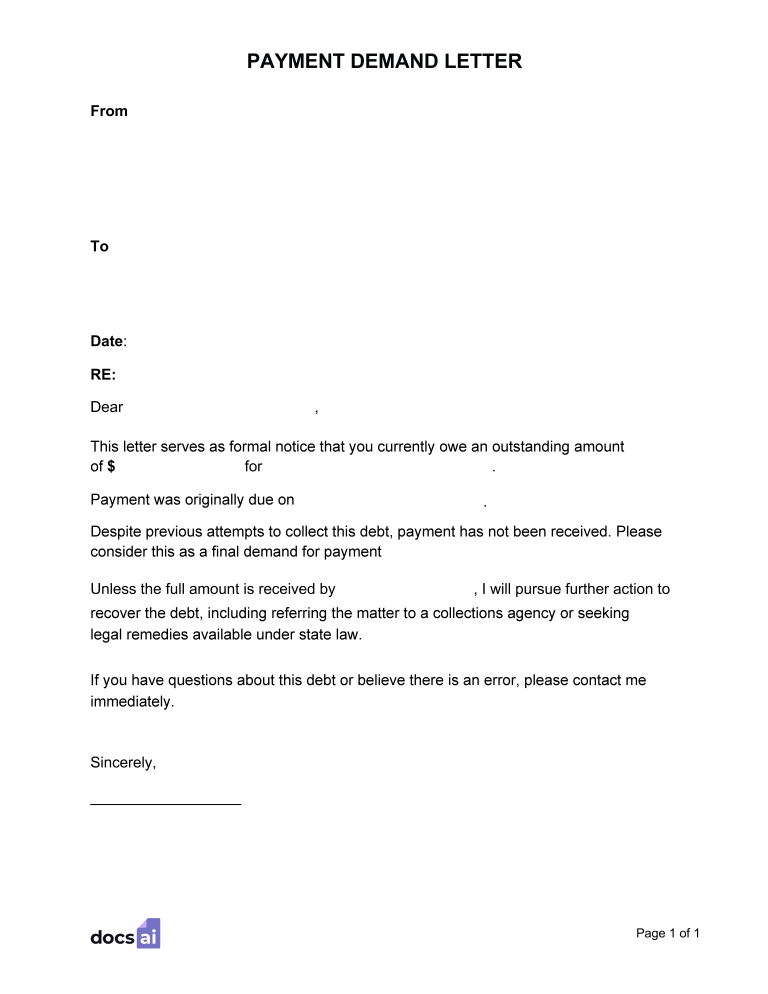Key Features
- Enhances Payment Process. Increases the chances that you will be taken seriously and recover the past-due amount.
- Maintains Compliance. Promotes adherence to debt collection laws, regardless of whether done in-house or through an agency.
- Professional Communication. Presents the structure and language to define an outstanding balance and aid in the collection effort.
- Customizable for any Industry. Provides an overdue payment template as a reliable tool for universal debt collection across industries (e.g., health, retail).
- Highlights Payment Terms. Reduces communication errors by explicitly documenting the amount owed with clear payment instructions.
How to Remedy (7 steps)
1. Verify Debtor Information
2. Review Applicable Laws
3. Practice Good Recordkeeping
4. Develop Demand Letter
Create a payment demand that plainly states the facts. Make it specific to the client and the circumstance, but make sure to declare:
- Sender Information
- Recipient Information
- Source of Debt
- Amount Owed
- Due Date
- Consequences of Noncompliance
5. Send the Letter and Verify Receipt
Deliver the letter so that you can prove its receipt. Certified mail with a return receipt and an email with read confirmation are both preferred methods.
6. Allow a Reasonable Response Time
Comply with the due date for response as specified in the letter and avoid pursuing additional collection actions until they initiate contact or the deadline passes.
7. Follow Up or Escalate Accordingly
In cases where the recipient does not comply with payment, issue a final notice. If this too remains unanswered, then consider;
- Handing the matter to a collection agency
- Reporting to a credit bureau (if appropriate and legal)
- Consult an attorney
Sample
PAYMENT DEMAND LETTER
From
[SENDER’S NAME]
[STREET ADDRESS]
[CITY, STATE, ZIP]
[PHONE]
[E-MAIL]
To
[RECIPIENT’S NAME]
[STREET ADDRESS]
[CITY, STATE, ZIP]
Date: [DATE]
RE: [INVOICE # OR DEBT SOURCE]
Dear [RECIPIENT’S NAME],
This letter serves as formal notice that you currently owe an outstanding amount of $[AMOUNT OWED] for [REASON FOR DEMAND].
Payment was originally due on [ORIGINAL DUE DATE].
Despite previous attempts to collect this debt, payment has not been received. Please consider this as a final demand for payment.
Unless the full amount is received by [DUE DATE], I will pursue further action to recover the debt, including referring the matter to a collections agency or seeking legal remedies available under state law.
If you have questions about this debt or believe there is an error, please contact me immediately.
Sincerely,
__________________
-
Anyone. Freelancers, contractors, landlords, and businesses are some examples that can use a demand for payment template to collect on past-due amounts.
-
Yes. Generally, this is 30 days after the invoice date, making this letter a crucial step in the accounts receivable process.
-
Yes, formalizing a request to rectify a personal loan by putting a demand for unpaid money in writing often prompts action.
-
Yes, consumers and other debtors often seek contact and resolution when a past-due invoice escalates to a demand letter.
-
10-15 days, unless state or federal laws applying to the industry (or the debtor) require otherwise.


